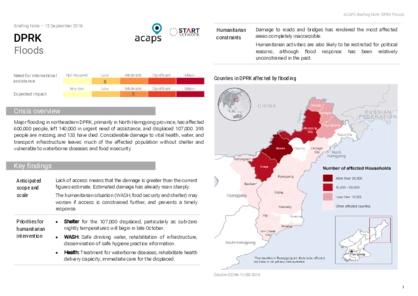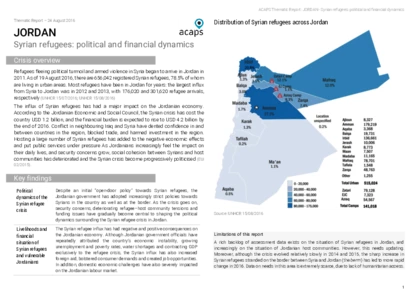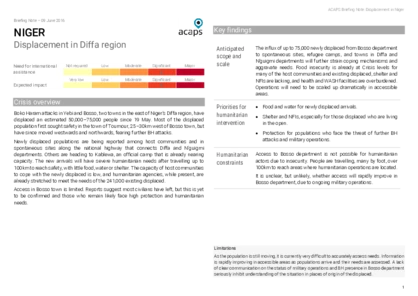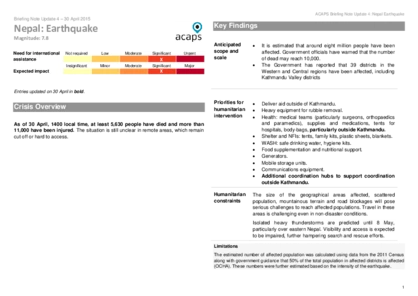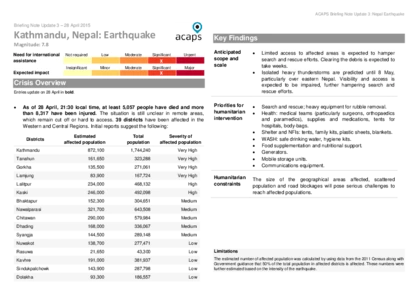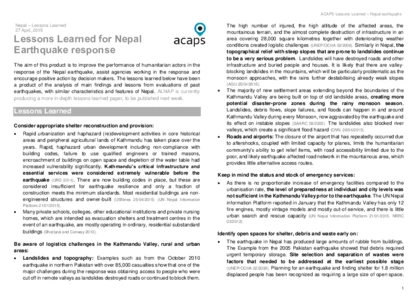Explore our
analysis products
archive
13 September 2016
DPRK: floods
DOCUMENT / PDF / 336 KB
Major flooding in northeastern DPRK, primarily in North Hamgyong province, has affected 600,000 people, left 140,000 in urgent need of assistance, and displaced 107,000. 395 people are missing, and 133 have died. Considerable damage to vital health, water, and transport infrastructure leaves much of the affected population without shelter and vulnerable to waterborne diseases and food insecurity.
07 September 2016
Kenya: drought
DOCUMENT / PDF / 372 KB
As of July, 1.2 million people in Kenya acutely need food assistance, an increase of 500,000 from February. Most food insecure people are in Garissa, Tana River, and Isiolo counties, in the centre-east. Such levels of food insecurity are typical for Kenya and do not represent any major deterioration.
25 August 2016
CAR: Cholera epidemic
DOCUMENT / PDF / 282 KB
166 cholera cases and 19 deaths have been recorded in CAR as of 21 August. The government declared an outbreak on 10 August, although cholera was first detected on 27 July in Mourou-Fleuve village, Ndjoukou subprefecture of Kemo. The outbreak has since spread to Damara subprefecture (Ombella Mpoko) and to at least four arrondissements in Bangui.
24 August 2016
Iraq: Displacement in KR-I
DOCUMENT / PDF / 553 KB
Some 250,000 Syrian refugees are registered in the Kurdistan Region of Iraq (KR-I), most having fled armed conflict in Syria in 2012 and 2014. 90% are Syrian Kurds. In 2014 and 2015, Iraqi IDPs fleeing Islamic State (IS) increased the population of KR-I by more than 30% in just two years. As of early August, KR-I hosts 955,200 IDPs, 28% of the total displaced in Iraq.
24 August 2016
Jordan: Syrian refugees - political and financial dynamics
DOCUMENT / PDF / 481 KB
Refugees fleeing political turmoil and armed violence in Syria began to arrive in Jordan in 2011. As of 19 August 2016, there are 656,042 registered Syrian refugees, 78.5% of whom are living in urban areas. Most refugees have been in Jordan for years: the largest influx from Syria to Jordan was in 2012 and 2013, with 176,020 and 301,620 refugee arrivals, respectively.
18 August 2016
Senegal: floods
DOCUMENT / PDF / 546 KB
On 24 July, high amounts of rainfall caused heavy flooding in some parts of Senegal. The districts Kaffrine and Kolda have reportedly been the heaviest affected, with Kaolack and Matam also receiving above average rainfall. Throughout Kaffrine district some 1,500 houses have been destroyed and 7,500 people affected.
18 August 2016
Nigeria: food security
DOCUMENT / PDF / 543 KB
Newly accessible areas of Borno and Yobe states and areas with active military operations face severely limited access to food. Levels of malnutrition are critical and populations face a substantially increased risk of mortality. The crude mortality rate (CMR) has surpassed the threshold of 2/10,000/day – used when classifying Famine (IPC Phase 5) – in several areas since June 2016.
12 August 2016
Boko Haram and Ansaru Stakeholder Analysis
DOCUMENT / PDF / 254 KB
Boko Haram (BH) is a Sunni Islamist armed group based in Borno state in northeast Nigeria. ‘Boko Haram’ translates from Hausa to ‘western education is forbidden’. The group was founded in 2002 by an Islamist cleric named Mohammed Yusuf in response to Nigeria’s democratic transition, nationalism and Western influence. The group’s official name is not Boko Haram but Jama’atu Ahlis Sunna Lidda’awati wal-Jihad, which means “People Committed to the Propagation of the Prophet’s Teachings and Jihad”.
11 August 2016
Bolivia: Drought
DOCUMENT / PDF / 269 KB
Drought has been ongoing since October 2015, but has recently deteriorated dramatically. The drought has now impacted seven departments and 106 municipalities. Over 160,000 people as well as 90,000 hectares of agriculture and over 121,000 cattle have been affected. 104 municipalities have declared a state of emergency, with losses in agricultural production reported at USD 35 million among small farmers of the Pailon municipality alone.
03 August 2016
Protection of Civilians in Armed Conflict Midyear Update: 01 January - 30 June 2021
DOCUMENT / PDF / 530 KB
The northeastern state of Assam has been particularly hard-hit by monsoon rains and flooding this season. Rainfall this year has been 20% above average in some areas of India, including in Assam.
Flooding worsened in Assam on 22 July, when new areas were submerged by the rising waters of the Brahmaputra River and its tributaries. As of 1 August, official figures show over 1.1 million people and over 3,300 villages across 21 out of 32 districts are affected. At least 32 people have died, most since 22 July.
03 August 2016
Humanitarian Response Plan 2021 - Afghanistan
DOCUMENT / PDF / 805 KB
Heavier than usual monsoon rains have caused floods in Bangladesh since 20 July. Some 3,200,000 people have been affected and up to 42 have died as of 3 August. Up to 300,000 people have been displaced in 16 different districts, mostly in the Northern and Central provinces (including Bogra, Faridpur, Gaibandha, Jamalpur, Kurigram, Kustia, Lalmonirhat, Madaripur, Manikganj, Nilphamary, Rajbari, Rangpur, Sariatpur, Sirajgonj, Sunamgonj, and Tangail). Most urgent needs are food provisions, WASH, and Emergency Shelter.
18 July 2016
South Sudan: Displacement in Juba
DOCUMENT / PDF / 350 KB
As of 16 July, an estimated 12,800 people remain displaced after fighting erupted in Juba over 7–11 July. They are at UN House, UNMISS Tongping, Don Bosco Gumbo, Rajaf village, St Joseph Parish Church, SSRC Compound, and San Francis Pitia school. Humanitarian agencies currently have access, but this is not stable as the ceasefire is fragile and the situation remains tense. Main needs include water, food, health, and protection.
13 July 2016
Northeast Nigeria: conflict
DOCUMENT / PDF / 2 MB
Over 14 million people are affected by conflict in northeast Nigeria and more than 10 million people are in need. A growing number of people are in urgent need of food assistance, with some of the worst affected areas possibly in Famine (IPC Phase 5). Alarming rates of acute malnutrition are emerging in Borno and Yobe and deaths as a result of SAM have been reported.
13 July 2016
Northeast Nigeria: conflict
DOCUMENT / PDF / 2 MB
Borno, Yobe and Adamawa state are most affected by the Boko Haram insurgency. The northeastern states are hosting the majority of IDPs. 1.3 million IDPs are in Adamawa, Borno, Gombe, and Yobe states. The entire resident population of these states (16 million) are considered affected by the Boko Haram insurgency. Humanitarian needs are severe and access is limited, particularly in Borno state.
12 July 2016
Nigeria: Malnutrition and food insecurity in Borno and Yobe states
DOCUMENT / PDF / 356 KB
Newly accessible areas of Borno and Yobe states are revealing extremely high rates of severe acute malnutrition, especially among 275,000 IDPs reported to live in 15 camps in Borno state. Information from recent rapid assessments, although limited, raises the possibility of Famine (IPC Phase 5) in the worst affected and least accessible areas of Borno. The Minister of Health has declared a nutrition emergency in Borno state.
09 June 2016
Niger: Displacement in Diffa region
DOCUMENT / PDF / 606 KB
Boko Haram attacks in Yebi and Bosso, two towns in the east of Niger’s Diffa region, have displaced an estimated 50,000–75,000 people since 19 May. Most of the displaced population first sought safety in the town of Toumour, 25–30km west of Bosso town, but have since moved westwards and northwards, fearing further BH attacks.
19 May 2016
Somalia: Floods in Hiraan
DOCUMENT / PDF / 412 KB
Increased rainfall since the beginning of May has led to a sharp rise in the Shabelle River and flooding. Heavy rainfall, river breakages, and flash floods have displaced 1,800 people and affected 16,500 in Beledweyne district, in Hiraan region in south-central Somalia.
20 April 2016
Nepal: Earthquake Update 3
DOCUMENT / PDF / 427 KB
As of 28 April, 21:30 local time, at least 5,000 people have died and more than 8,300 have been injured. The situation is still unclear in remote areas, which remain cut off or hard to access. 39 districts have been affected in the Western and Central Regions.


